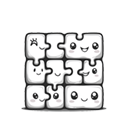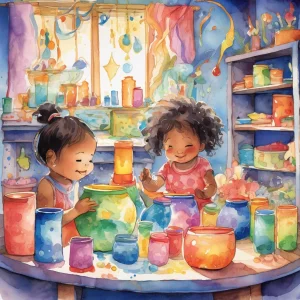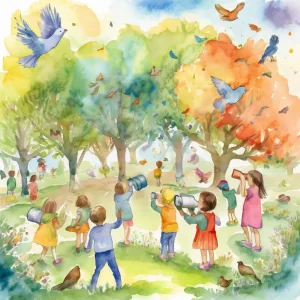Activity
Similar Activities
Sensory Texture Hunt for Developing Skills
Children’s Age: 4–7 years
Activity Duration: 5 – 10 minutes
Let's go on a Sensory Treasure Hunt! We will explore different textures like smooth stones, soft feathers, and rough sandpaper. You can use blindfolds for an extra challenge if you…
Activity Duration: 5 – 10 minutes
Healthy Harvest: Clay Creations - Making Healthy Food Sculptures
Children’s Age: 4–6 years
Activity Duration: 10 – 15 minutes
Engage children in the "Clay Creations - Making Healthy Food Sculptures" activity to boost their adaptive skills, self-care abilities, and academic progress through crafting nutrit…
Activity Duration: 10 – 15 minutes
Colorful Sorting Fun: Exploring Colors and Shapes
Children’s Age: 1.5–2 years
Activity Duration: 5 – 10 minutes
"Colorful Sorting Fun" is an engaging activity designed for children aged 18 to 24 months to boost their fine motor skills, cognitive abilities, and color recognition. Prepare colo…
Activity Duration: 5 – 10 minutes
Enchanted Numbers: Number Hunt Obstacle Course Adventure
Children’s Age: 2–3 years
Activity Duration: 15 minutes
Engage children aged 24 to 36 months with the "Number Hunt Obstacle Course" activity, a fun game that enhances number recognition skills. Set up a safe course with physical activit…
Activity Duration: 15 minutes
Enchanted Nature Hunt: Sensory Exploration Adventure
Children’s Age: 1.5–2 years
Activity Duration: 5 minutes
The Sensory Nature Hunt activity is tailored for children aged 18 to 24 months, offering an engaging outdoor sensory experience. Through exploring nature using touch, sight, and so…
Activity Duration: 5 minutes
Imaginary Adventures: Mini Bowling Feelings Story Game
Children’s Age: 2–5 years
Activity Duration: 10 minutes
An engaging activity promoting sensory development, creativity, reading, and storytelling.
Activity Duration: 10 minutes
Picnic Adventure: Pretend Cooking Play for Toddlers
Children’s Age: 2–3 years
Activity Duration: 10 – 30 minutes
An imaginative activity where children (ages 2-3) engage in pretend cooking during a picnic adventure.
Activity Duration: 10 – 30 minutes
Nature Shapes Adventure: Bird Watch & Scavenger Hunt
Children’s Age: 4–5 years
Activity Duration: 10 minutes
An outdoor activity for children aged 4-5 years combining bird watching and shape recognition.
Activity Duration: 10 minutes
Digital Beats and Hoop Dreams Coding Adventure
Children’s Age: 9–12 years
Activity Duration: 10 – 20 minutes
An engaging coding activity integrating music production, basketball skills, and teamwork for children aged 9-12 years.
Activity Duration: 10 – 20 minutes
Enchanted Melodies: The Musician Money Mystery Game
Children’s Age: 9–12 years
Activity Duration: 10 minutes
An engaging activity where children learn about probability and famous musicians while earning money for clues in a mystery game.
Activity Duration: 10 minutes
Gratitude Journey: Writing Thank-You Notes Experiment
Children’s Age: 6–8 years
Activity Duration: 10 – 20 minutes
A creative activity for children aged 7-8 to write thank-you notes, enhancing cognitive and communication skills.
Activity Duration: 10 – 20 minutes
Musical Freeze Painting: A Creative Dance Adventure
Children’s Age: 3 years
Activity Duration: 10 – 20 minutes
An engaging activity combining painting with musical freeze dance to promote creativity and play skills.
Activity Duration: 10 – 20 minutes


























